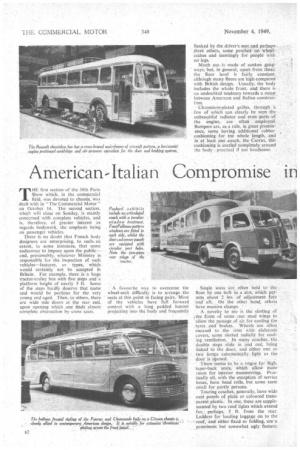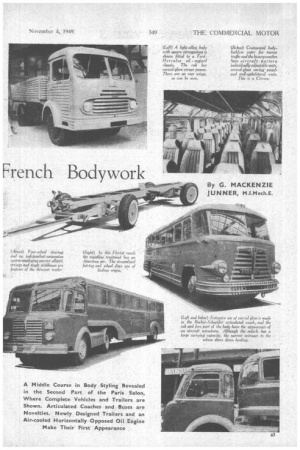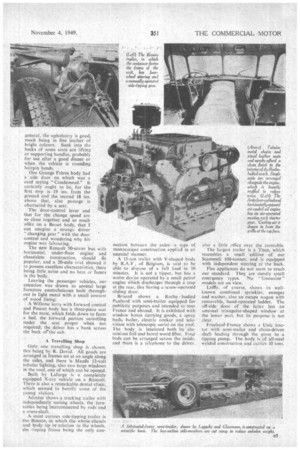American-Italian Compromise in French Bodywork
Page 36

Page 37

Page 38

Page 39

If you've noticed an error in this article please click here to report it so we can fix it.
By G. MACKENZIE JUNNER, M.I.Mech.E. THE first section of the 36th Paris Show which, in the commercial field, was devoted to chassis, was dealt with in "The Commercial Motor" on October 14. The second section, which will close on Sunday. is mainly concerned -with complete vehicles, and is, therefore, of greater interest as regards bodywork, the emphasis being on passenger vehicles.
There is no doubt that French body designers are enterprising, to such. an extent, in some instances, that some endeavour to impose upon the public— and, presumably, whatever Ministry is responsible for the inspection of such vehicles—features, or types, which woidd certainly not be accepted ih Britain. For example, there is a huge tractor-trailer bus with five steps and a platform height of nearly 5 ft. Some of the steps hardly deserve that name and would be perilous for the very young and aged. Then, in others, there are wide side'doors at the rear end. upon opening which one finds almost complete obstruction by cross seats. A favourite way to overcome the wheel-arch difficulty is to arrange the seats at this point in facing pairs. Most Of the vehicles have full forward control with a long padded bonnet projecting into the body and frequently flanked by the driver's_ seat and perh4ps three others, some perched on Wheelarches and Seemingly for people with
no' legs. •
Much use, is made of sunken gangways, but, in general; apart from these-. the floor level is fairly constant. although Many floors are high compared with British design. Usually, the body includes the whole front, and there is an undoubted tendency towards a mean between American and Italian construction.
• Chromium-plated grilles, throtigh few of which can clearly be seen the unbeautiful radiator and even parts of the engine, are often. . employed. Bumpers are, as a rule, in great prorninence, some having additional tubber cushioning' for tne whole length, and in.' at least one coach, the Currus, this -cushioning is carried completely around the body--practical if not handSome.
Single seats arc often held to the floor by one bolt in a slot, which permits about 2 ins, of adjustment fore and aft. On the other hand, others have massive clamps.
A novelty to me is the slotting of the front of some rear mud wings to allow the passage of air for cooling the tyres and brakes. Wheels are often encased to the rims with elaborate covers. some slotted radially for cool. irag ventilation. In many coaches, the double steps slide in and out, being linked to the door, and either one or two lamps automatically. light as the door is Opened.
There seems to be a vogue for high, taper-back seats; which alloW more room for interior manceuvring. Practically all, with the exception of service buses, have head rolls, but some seem small for portly persons.
Touring coaches, generally, have wide cant panels of plain or coloured transparent plastic. in one, these are supplemented by two roof lights which extend for, perhaps, 5 ft. from the rear. Ladders for loading luggage Onto the roof, and either fixed or folding, are la . prominent but somewhat ugly feature.
Occasionally they are replaced by steps sunk into the rear panels.
Emergency exits receive much consideration. There are sometimes two fully opening windows for this purpose at each side, and, maybe, a large hinged light at the rear.
Coach seats are mainly adjustable_ In some the back can be inclined as desired; in others the seat moves horizontally, but the controls are often over-prominent and their large knobbed levers at different angles form a veritable forest. There are, of course. certain that are neat and inconspicuous.
All-metal construction has almost swept the board, and the chassisless type is advancing. Luggage racks are usually of polished metal, some with cord or pierced-metal "nets "; many are very narrow and obviously for quite small articles. As a rule, luggaelaccommodation is good, there being large lockers along the sides and at the back for 35 or so standard suitcases. One Bernard 41-seater has a neat lavatory compartment at the rear, which replaces two seats, one being left at each side of it.
The Italian Viberti 34-seater on a Fiat chassis is probably the nicest' looking coach on show. Even the cant windows have concertina-type curtains lifting from the bottom, and there is dual lighting—white for day and, blue for night. Each seat back, which is
adjustable, carries a 5-in. by 4-in. picture of some special view, and at one side is an ashtray, with a matching mirror at the other; also a spring clip for papers. In other makes of body there is often a small folding table.
Viberti also makes a coach with electric kitchen, lavatory with hand basin, refrigerator and sink.
Much attention is paid to ventilation, air conditioning and heating. Often there are channels running along each side of the roof, with several adjustable vents and perhaps an electrically oper ated fan at the front of each channel. Some heating is still done from the exhaust.
One Le Bastard body has radio with speakers along each side, also courier's microphone. The seats are staggered in pairs to give more elbow room, and there are rubber-covered foot rests. Many side windows-have blue or yellow plastic sun visors over them.
The Saurer-S.A.V.LA. 15 of rnonobloc constriction embodying Saurer units, including a rear engine mounted crosswise.
Curved windscreens of glass or Curved plastic panels at the sides of straight screens have beeome popular.
Many buses for local service, such as the Renault with Scemia body, are equipped with cash desks, the cashier having control by press buttons of the door and stop-start signals.
A " problem " handle low down on the front pillar of a Geneve bus body puzzled me for a time. It proved to be for unlocking the folding doors externally, these being normally controlled by the driver. Incidentally, many doors have projections near their base to fill the step recess at floor level when the doors are shut.
Single-deck Trolley buses There are two or three trolleybuses, all single-deckers. These include the Jacquemond, of monozocque tubularsteel construction. Normally this seats 26 and will take 50 standees, or, in at, emergency, a total of 92. The overall length is 10 metres.
Window anti-rattlers on some buses seem crude —merely small rubber rollers at each side of the glass at top and bottom.
Some emergency doors are protected by a hinged bar, on which is a springheld collar which must be pulled back to let it drop. Side curtains are often fitted, some of the spring-roller type with three holding positions. Tubular lighting working an 12 volts is popular. Dunlopillo seats are much in vogue. In
general, the upholstery is good, much being in fine leather of bright colours. Sunk into the backs of some seats are lifting or supporting handles, probably fOr use after a -good dinner or when the vehicle is rounding hairpin bends.
One Grange Freres body had a side door on which was a card saying "Condemned." It certainly ought to be, for the first step is 19 ins, from the ground and the second 18 ins. above that, also passage is obstructed by a seat.
The door-control lever and that for the change speed are so close together and so much alike on a Besset body, that I can imagine a strange driver "changing gear" with the door control and wondering why his engine was labouring.
The new Renault 50-seater bus with horizontal, under-floor engine and chassisless construction, should be popular, and a 20-mile trial showed it to possess excellent characteristics, there being little noise and no heat or fumes in the body.
Leaving the passenger vehicles, our attention was drawn to several large furniture pantechnicons built throughout in light metal with a small amount of wood lining.
A Willerne lorry with forward control and Pottzet body has a three-piece seat for the mate, which folds down to form a bed, the forward portion swivelling tinder the seat proper when not required; the driver has a hunk across the back otthe cab.
A Travelling Shop Only one travelling shop is shown, this being by R. David. All goods are arranged in frames set at an angle along the sides, and there is Mazda 12-volt tubular lighting, also two large windows in the roof, one of which can he opened.
Built by Laforge is a completely equipped X-ray vehicle on a Renault. There is also a remarkable dental clinic, which seemed to horrify some of the young visitors.
• Adrazur shows a tracking trailer with independently sprung wheels, the turntables being interconnected by rods and a cross-shaft.
N most curious side-tipping trailer is theBenoto, in which the whole chassis and bOdy tip in.-relation to the wheels, the Hoping frame being the only con nection between the axles—a mx of monococque construction applied in an unusual manner..
A I5-ton trailer with V-shaped body by R.A.Y , of Belgium, is said to he able to dispose of a full load in 10 minutes. It is not a 'tipper, but has a worm device operated by a small petrol engine Which discharges through a trap at the rear, this Having a screw-operated sliding door.
Brisard shows a Roche bodied Panhard with semi-trailer equipped for publicity purposes and intended to tour France and abroad. It is exhibited with window boxes carrying goods, a spray bath, boiler, electric cooker and television with telescopic aerial on the roof, The -body is insulated both by alit7 minium foil and lsorel wood fibre. Fonr beds can be arranged. across the inside, and there is a telephone to the driver. also a little ol-Tiee over the turntable.
The largest trailer is a Titan, which resembles a small edition of our Scammell 100-tonner, and is equipped with independent steering at the back.
Fire appliances do not seem to reach our standard. They are mostly small emergency types. No " limousine" models are on view.
Laffly, of course, shows its wellknown combined sprinkler, sweeper and washer, also an escape wagon with removable, hand-operated ladder. The off-side door of the latter has an unusual triangular-shaped window at the lower part, but its purpose is not clear.
Fruehauf-France shows a linic tractor with semi-trailer and chain-driven shaft leading through the pivot to a tipping pump. The body is of all-steel welded construction and carries 10 tons.




















































































